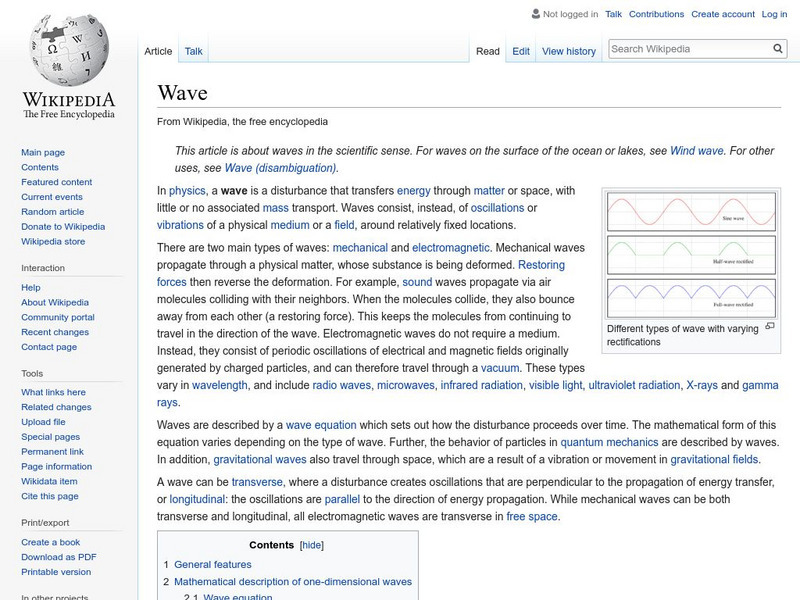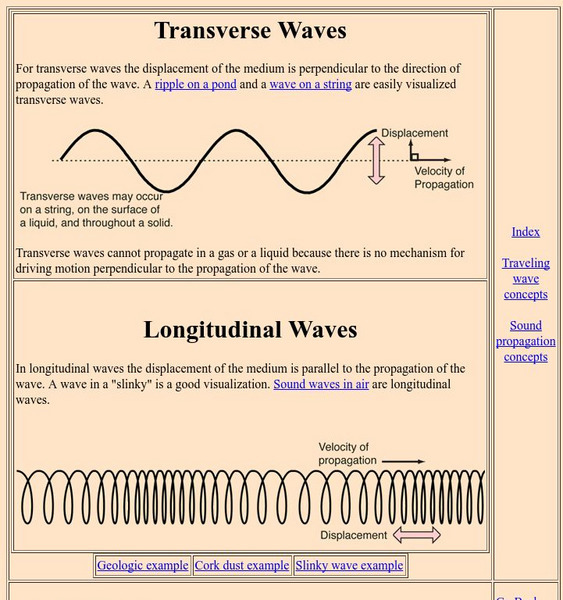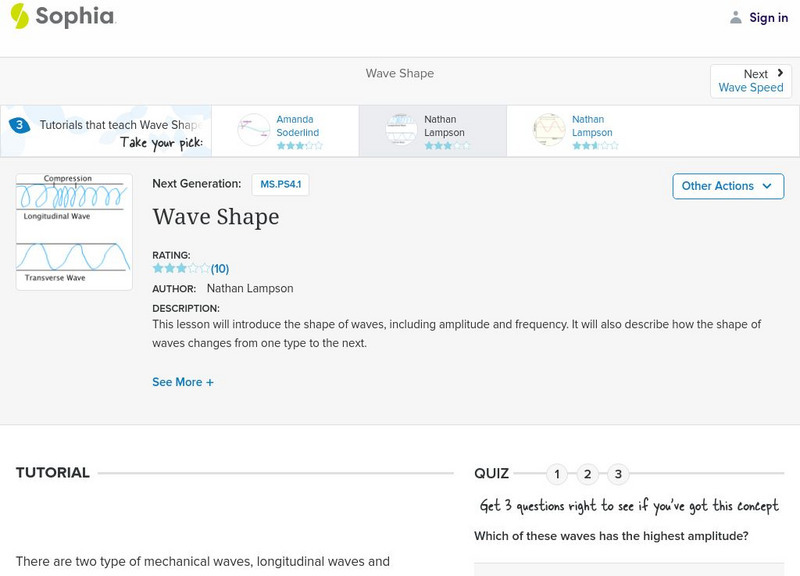Wikimedia
Wikipedia: Wave
An in-depth encyclopedia article from Wikipedia on waves gives a definition for what a wave is. Other content in the article includes a list of examples and characteristics of waves, information about the difference between transverse...
CK-12 Foundation
Ck 12: Plix: Types of Waves: Mechanical Wave
[Free Registration/Login Required] Move the points to change the frequency and amplitude of the waves while making the waves transverse or longitudinal according to the labels.
BBC
Bbc: Gcse Bitesize: Why Do Scientists Think That Light and Sound Are Waves?
Light travels as transverse waves and can travel through a vacuum. Sound travels as longitudinal waves and needs to travel through a solid, liquid or gas. Read about the properties of light and of sound, and learn the differences between...
Georgia State University
Georgia State University: Hyper Physics: Wave Motion
Two wave graphs depicting a sine wave and relating the various characteristics (wavelength, amplitude, frequency, and period) of a wave to each other. The site includes an interactive JavaScript form in which the visitor enters one...
Pennsylvania State University
Kettering University: Vibration & Waves
A short tutorial providing general information about waves, their categories, properties and behaviors. Includes several animations and some practice questions with answers.
BBC
Bbc: Gcse Bitesize: General Properties of Waves
Light travels as waves. Waves can be described by their amplitude, wavelength and frequency. The speed of a wave can be calculated from its frequency and wavelength.
Georgia Department of Education
Ga Virtual Learning: Waves
Through informational text, interactive activities, and practice problems, students learn about the properties of waves, and how they transfer energy.
Georgia State University
Georgia State University: Hyper Physics: Transverse and Longitudinal Waves
The physics tutorial illustrates and explains the distinction between transverse and longitudinal waves. Related links provided.
Khan Academy
Khan Academy: Transverse and Longitudinal Waves Review
Overview of key terms and skills for waves, including how to identify longitudinal and transverse waves.
Khan Academy
Khan Academy: Characteristics of Longitudinal and Transverse Waves
Test yourself on the topics of identifying the characteristics of a longitudinal or transverse wave such as the wavelength, crest, and areas of compression with this multiple choice quiz.
Physics Classroom
The Physics Classroom: Waves and Sound: Standing Wave Patterns Interactive
Students investigate the formation of standing waves, the vibrational patterns associated with the various harmonics, and the difference between transverse and longitudinal standing waves.
Khan Academy
Khan Academy: Wave Characteristics Review
Review the characteristics of periodic transverse and longitudinal waves such as wavelength, crest, trough, amplitude, expansion, and compression.
Sophia Learning
Sophia: Transverse and Longitudinal Waves
This lesson will describe the difference between transverse and longitudinal waves.
Sophia Learning
Sophia: Wave Shape: Lesson 5
This lesson will introduce the shape of waves, including amplitude and frequency. It will also describe how the shape of waves changes from one type to the next. It is 5 of 5 in the series titled "Wave Shape."
CK-12 Foundation
Ck 12: Physical Science: Wavelength
[Free Registration/Login may be required to access all resource tools.] What wavelength is and how it relates to the energy of a wave.
Ducksters
Ducksters: Physics for Kids: Basic Science of Waves
Kids learn about waves in the science of physics including types such as mechanical, electromagnetic, transverse, and longitudinal. Facts and examples are included.
TeachEngineering
Teach Engineering: Sound and Light
The Sound and Light unit provides students with an understanding of sound and light waves through the theme of the "Sunken Treasure," a continuous story line throughout the lessons. In Lessons 1-5, students learn about sound, and in...
TeachEngineering
Teach Engineering: Wind Chimes
Using their knowledge of physics, students will build a wind chime. Mathematical computations will be done to determine the length of the pipes.

















